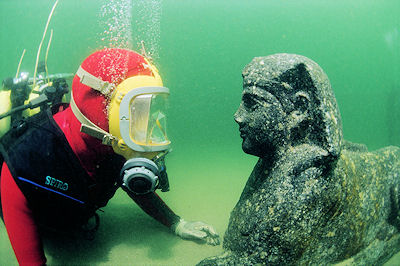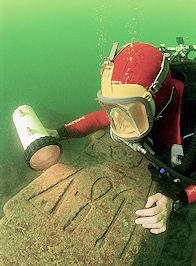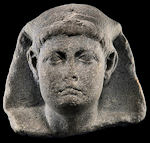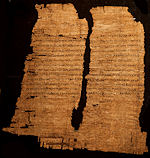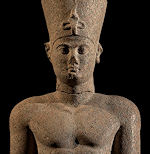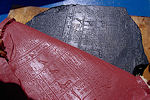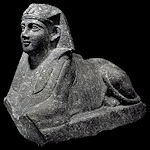| A SLIDE SHOW CREATED BY THE HISTORY PLACE FEATURING
HIGHLIGHTS FROM THE EXHIBITION
AT THE FRANKLIN INSTITUTE IN PHILADELPHIA
|
Introduction
Organized by National Geographic and Arts and Exhibitions International (AEI), with help from the Egyptian Supreme Council of Antiquities and the European Institute for Underwater Archaeology (IEASM), the exhibition features about 150 artifacts from Cleopatra’s time including statuary, jewelry, daily items, coins and religious tokens that archaeologists have uncovered. Also on display is an original papyrus document that scientists
believe was written in Cleopatra’s own hand.
Cleopatra, the last great Pharaoh before Egypt succumbed to Roman opposition, lived from
69–30 B.C. (Ptolemaic period), with a reign marked by political intrigue and challenges to her throne. She captivated
two of the most powerful men of her day, Julius Caesar and Mark Antony, as she attempted to restore Egypt to
its former superpower status.
After Egypt succumbed to Roman forces and Cleopatra famously took her own life following the
suicide of her lover Mark Antony, the Romans attempted to wipe her legacy from the pages of history. Cleopatra
thus has remained one of history’s greatest enigmas, and her final resting place is one of Egypt’s unsolved mysteries.
Presently there are two ongoing expeditions in the search for Cleopatra – one on land and one under the sea. On land in Egypt, Dr. Zahi Hawass, Egypt’s pre-eminent archaeologist and secretary general of the Supreme Council of Antiquities, along with a team of archaeologists, are searching for the tomb of the ill-fated lovers
Cleopatra and Mark Antony. Never-before-seen artifacts referencing Cleopatra, excavated by Hawass’ team at
the temple of Taposiris Magna, about 30 miles west of Alexandria, are featured in the exhibition at The Franklin Institute.
Off the Mediterranean coast of Egypt, the search by Franck Goddio, French underwater archaeologist and director of IEASM, has resulted in one of the most ambitious underwater expeditions ever undertaken. With financial support from the Hilti Foundation, Goddio and his team have uncovered Cleopatra’s royal palace and the two ancient cities of Canopus and Heracleion, which had been lost beneath the sea after a series of earthquakes and tidal waves nearly 2,000 years ago. The exhibition at The Franklin Institute features remnants from the grand palace where Cleopatra ruled along with underwater footage and photos of Goddio’s team retrieving artifacts from the ocean
and bringing them to the surface for the first time in centuries.
MYTHS vs. FACTS of CLEOPATRA
MYTH: There was only one Cleopatra.
FACT: The Cleopatra we are familiar with is Cleopatra VII Thea Philopator. There are at least seven other known “Cleopatras” who lived during the Ptolemaic dynasty in which Cleopatra VII ruled, including her daughter, Cleopatra Selene II.
MYTH: Cleopatra was an Egyptian.
FACT: Cleopatra was of Greek descent. She was born during winter 69-68 BC, probably in Alexandria. She belonged
to the Lagides dynasty, a dynasty of Macedonian (North Greece) origin, who ruled Egypt since the end of the
IV century BC. The founder of her dynasty, Ptolemy I, served as a general to Alexander the Great and became
ruler of Egypt after Alexander’s death. The Ptolemies then established Alexandria, Egypt as the center of
culture and commerce in the ancient world. This is where Cleopatra VII later ruled and lived in the royal
palace.
MYTH: Cleopatra was a seductress.
FACT: Popular culture portrays Cleopatra as a temptress, seducing Julius Caesar and becoming his mistress, then later
luring Mark Antony. However, Cleopatra had her children and her country’s best interest in mind. At that
time, Rome was the greatest superpower of the Mediterranean. Called the Imperator, Julius Caesar was a
victorious commander and a very influential leader. Rome and Egypt had an uneasy alliance. Rome needed
Egypt’s wheat. Egypt needed Rome’s protection. To secure power, Cleopatra navigated an alliance through
her union with Caesar. After Caesar’s death, Cleopatra entered into an alliance with Mark Antony, one of the
three rulers of Rome. Later, when he was involved in a power struggle with Caesar’s nephew Octavian, Antony
and Cleopatra joined forces to attempt to control both Rome and Egypt.
MYTH: Cleopatra took her own life because she was heartbroken by her lover’s death.
FACT: Egypt fell to the Romans after a crushing defeat of Cleopatra’s navy by Octavian’s Roman forces. Mark
Antony committed suicide shortly thereafter. It was rumored that Cleopatra would be captured by Octavian and
paraded through the streets of Rome in shackles as a war prisoner by Octavian. Nearly two weeks after Mark
Antony took his own life, she followed suit, likely in part to prevent the shame of public humiliation.
MYTH: Cleopatra died from the bite of a poisonous snake.
FACT: While legend says that she died from the bite of an asp, a poisonous snake, we still today are not sure what
killed Cleopatra. The snake bite may have been an invention of the Romans in an attempt to defame her
memory and connect her to something with vile and evil connotations. Cleopatra was very knowledgeable
about poisons, writing books on the subject. Other theories suggest that she may have ingested a poisonous fig
or applied a toxic substance to her skin.
Source: Information based on National Geographic Channel’s Egypt Unwrapped: Cleopatra, which first aired on December 28, 2008.
About the Undersea Expedition
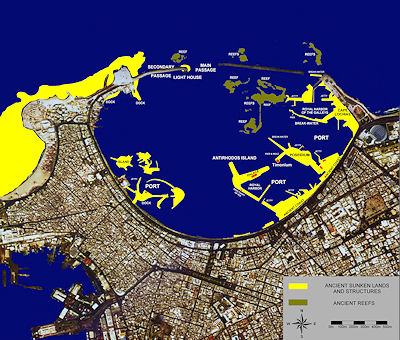 |
After fourteen years of electronic probing and underwater archaeological exploration, the outline of the famous Portus Magnus ("Great Port") and the sites of the main monuments have been clearly established. Here the land surface and ancient port infrastructures of the Portus Magnus have been projected (in yellow) onto a satellite image of modern Alexandria.
EarthSat NaturalVue © Franck Goddio/Hilti Foundation |
Below Left: A diver is eye-to-eye with a sphinx made out of black granite. The face of the sphinx is believed to represent Ptolemy XII, father of the famous Cleopatra VII. The sphinx was found during excavations in the ancient harbor of Alexandria.
Below Right: A diver of Goddio's team is illuminating hieroglyphic inscriptions of a door jamb's fragment, discovered in Alexandria's ancient Great Harbor and dating from the 26th dynasty (Apries, 6th century BC).
© Franck Goddio / Hilti Foundation, Photos: Jerome Delafosse |
| |
| The painstaking archeological research culminates each
year with the 6-week dive season. Strict archaeological standards are utilized during the exploration and excavation
phases. The excavated objects are then made available to the public through museums and
exhibitions. |
Right: The torso of a statue of a pharaoh is being raised. The colossal statue is of red granite and measures over 16.4 ft. It was found close to the big temple of sunken Heracleion.
© Franck Goddio / Hilti Foundation, Photo: Christoph Gerigk |
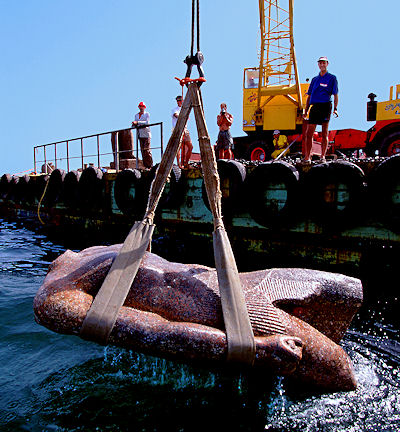 |
About The Franklin Institute
| Located in the heart of Philadelphia, The Franklin Institute is a renowned and innovative leader in the field of science and
technology learning. As Pennsylvania’s most visited museum, it is dedicated to creating
a passion for learning about science by offering access to hands-on science education. Below Left: Students come face-to-face with the Sphinx of Ptolemy XII, the father of Cleopatra. Below Right: Many Egyptian statuettes have been found bearing the likenesses of revered gods. Photos
© Lisa Godfrey / The Franklin Institute |

Begin
The History Place - Slide Show
Index of
Objects

|
![]()


